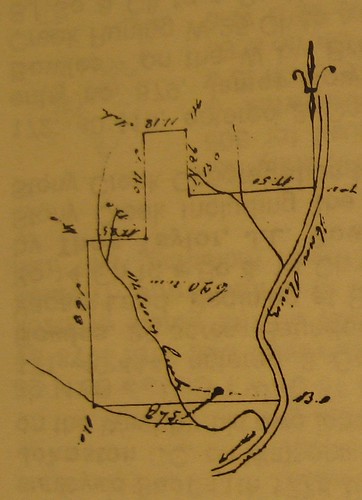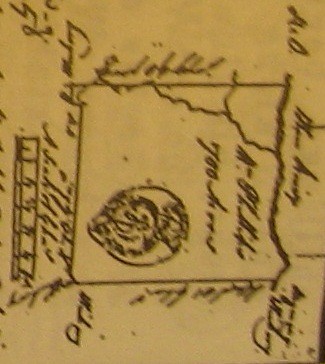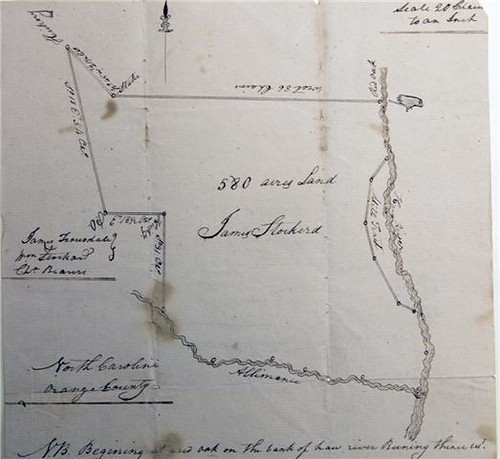
[If you are missing part of the picture on the east, you can click through to see the complete image.]
As shown, the diamond shaped Tract 11 does not appear to include land on the east side of the Haw River. However, the drawing cannot be taken literally, as the land and rivers are very schematic, not to scale.
According to Fred Hughes, the western extremity of this massive tract just about touched the old Rowan/Orange County line on the west. A 100,000 acre square is exactly 12.5 miles on a side and relying on Fred Hughes’s Historical Documentation: Guilford County, I measure (using Google Earth) that Tract #11 cut across the Haw River into a slice of the Lovick Tract, just missing any part of the Little Tract – which if correct would put the Swepsonville millsite distinctly outside Tract 11, though just barely.
However this would be a troubling conclusion. All of the documents involved in selling the mill from John Armstrong to John Trousdale show that the underlying title was Henry Eustace McCulloh’s. An agreement in the Armstrong Papers at the Southern Historical Collection shows that in July 1764 Armstrong agreed to build a saw mill and operate it. He was to pay 50 pounds a year to Henry Eustace McCulloh and at the end of 4 years McCulloh was to deed him a 1/2 undivided interest in the mill. This seems to have transpired as planned and McCulloh and Armstrong jointly sold the mill to John Trousdale only a few years after Armstrong's 50% interest vested. Yet the Armstrong/Trousdale mill site seems to be just north of the McCulloh line, putting it outside of McCulloh's Great Tract #11.
Land Grants on the West Bank
In order to more precisely fix McCulloh's S45E line as it intersected the Haw River, let's take a look at the Granville grants for that area (Granville's records being far more complete than McCulloh's).
John Campbell
This 1761 Granville grant to John Campbell is an obvious place to start:

The textual description of this tract refers to the S45E line here as “a line called McCullock’s” and the survey clearly shows one of the Trading Path fords on the Haw River. An important question, then, is which ford on the Haw this was. As I will show in a moment, this was definitely the ford at Swepsonville.
Conrod Long
Another interesting grant in that area is Orange Co. State Land Grant #167 to Conrod Long (below). Long's State Grant was dated 1779, but he was probably on this property much earlier. As the survey clearly shows Nelson Branch ran through and just off the south edge of this property.

My Historical Atlas of the Haw River says “John Hopkins, Samuel Shaw and William Galbreath all ran ferries near the mouth of Back Creek (Orange Court of Pleas and Quarter Session Minutes for May 1780, Feb 1783, May 1783 and Feb 1784).” I didn’t cite it in the Atlas, but there are deeds from Hopkins to Shaw conveying two parcels on opposite sides of the Haw River, recorded at Deed Book 2, pg 363 and 364 (1783). The deed for the west side of the Haw (page 364) reads “begin at a sweet gum on Nelsons Creek . . .” demonstrating that Nelson's Creek or Branch is the creek directly opposite the mouth of Back Creek. Using that reference point and the Conrod Long grant, we can sketch Mr. Long's farm onto a modern topo map.
William Phillips
Conrod Long’s grant indicates that the property owner to the south of him was named Phillips. This appears to have been William Phillips, who received a Granville grant in 1761 for 700 acres on the west side of the Haw (#538). The accompanying survey (shown below) plainly shows a creek flowing into the Haw, but neither the survey nor the legal description mentions the name.

I assume that this is Nelson Creek as shown on the Conrod Long grant and that William Phillips is the Phillips mentioned in the legal description of Long's grant. It is also notable that the 1761 grant to John Campbell refers to the property owner to the north as being Phillips. Note also that Campbell’s northern line was 81 chains from the Haw River due west to McCulloh’s line and Phillips southern boundary was also 81 chains due west from the Haw (and the next call of Phillips’s deed is N45W – a perfect match to McCulloh’s line, although McCulloh is not mentioned in the Phillips grant).
Putting It All Together
Thus, Conrod Long was just north of Nelson Branch. To the south of Long was William Phillips straddling the mouth of Nelson Branch, directly opposite Galbreath and Hopkins at the mouth of Back Creek. And to the south of Phillips was John Campbell. Mapping all three of these land grants together, it is clear that John Campbell’s grant was immediately opposite what would later be the textile mill in Swepsonville, with his southernmost corner being about 15 chains above the confluence of Big Alamance Creek and the Haw. Thus it would seem that the McCulloh line intersected the Haw River immediately south of the mill site at Swepsonville, rather nicely corroborating the result I got from projecting the location based on Historical Documentation: Guilford County.
The Mill Petitions
The Orange Court of Pleas and Quarter Sessions minutes for August 1761 record that John Campbell petitioned for permission to build a gristmill on the Haw River – just a few weeks before Campbell received his grant from Granville on 8/23/1761. However, notably Campbell’s mill petition was rejected and he gave notice of appeal to Halifax Court. It would be interesting to see if Halifax Court records of this case still exist.
In August 1763, the Orange Court of Pleas minutes show that Henry Eustace McCulloh condemned land of Robert Nugent in order to build a mill on the Haw River opposite land owned by McCulloh. My interpretation is that this petition relates to the same site as John Campbell's petition and that Henry Eustace McCulloh was a successor in interest to Campbell. This seems especially plausible because John Campbell was one of Henry McCulloh's agents in North Carolina. Henry spent most of his time in England and transacted business in North Carolina through some close associates to whom he granted Powers of Attorney. The surviving POA's name Henry's son Henry Eustace McCulloh, Alexander McCulloh and John Campbell (5 Colonial Records of North Carolina 779-782; 6 CR 532-536).
In other words, I think John Campbell obtained his Granville grant on behalf of Henry McCulloh (or Henry Eustace McCulloh) and merely held the property in trust for him; that might sound like an odd arrangement today, but it was a common method of operation for the McCullohs. All of this would explain how Henry Eustace McCulloh came to sell John Trousdale a mill site just outside of Tract 11.
Robert Nugent
This theory has left me with another curious question: Who was the Robert Nugent from whom McCulloh was condemning land? He must have owned the land that later became the Armstorng/Butler Tract - the east bank of the Haw at the Swepsonville mill site. But the Orange County Deed Books show no deeds to or from Robert Nugent - or any Nugent for that matter. Neither does the name Nugent appear in William D. Bennett's index of Orange land records (which includes the Granville papers). In fact, I cannot find any sign of Robert Nugent in any source related to 18th century Orange County.
The only clue I have come across is that there was a Robert Nugent in England who was oneo fthe Lords of Treasury in 1754. Perhaps Robert Nugent was the person who obtained supposed title to the Forster, Little and Lovick Tracts from former Gov. George Burrington. Burrington had nominally owned 40,000 acres in the Hawfields just east of Tract 11, but only 30,000 acres of that passed to Samuel Strudwick. The title to the other 10,000 acres has never been accounted for, although the area where that 10,000 acres lies is along the Haw River between the mouths of Back Creek and Big Alamance Creek - in other words all around Swepsonville.
James Stockard
The land on the west bank of the Haw above Alamance Creek eventually escheated to the University of North Carolina and was sold to James Stockard:

Stockard's 580 acres here includes almost all of the 1761 John Campbell grant (exceptin part carved out for 'the mill tract') as well as a a part of Tract 11. Notably Stockard's deed mentions that the property owner to the north is Phillips, quite consistent with our interpretation of the location of the Campbell grant. Much of this property eventually became a part of Archibald Debow Murphey's estate, The Hermitage.
Update - All of the 12 great tracts have a legal description - metes and bounds, as found in the State Archives, when Mathew Rowan completed the survey in 1747. These 12 great tracts were surveyed as 8-12,500 acre tracts. Therefore, A great tract has 8 entries, and for Tract 11, Rowan used the Haw River as a beginning boundary line (his NE line). There are three sub-tracts (again as 12,500 acres each) which state "on the Haw River" which answers why the 45 degree angle. The Haw River became the angle. ALL OF THE 12 great tracts - survey boundary details - are available on Microfilm NC State Archives Land Grant Reecord Books - Bk #19 (S.108.160.5N). Yet, despite the survey by Rowan, it appears that Tract 11 had issues. Based on deed research (grants) it APPEARS that they sold land on a "subtract" line and not on the boundary line. As of yet, no primary document provides insight/details about this issue. However, fact is, the very NE quadrant of this tract was not sold via McCulloh grants. In addition, there are some granville grants inside the McCulloh boundary. This collision was documented (not specific to this tract) between McCulloh and Granville and a second agreement was issued April 17, 1761. IT COULD HAVE been this very tract issue which caused the creation of the second agreement. This second agreement specifically directed Granville's land agents (Edenton) NOT to accept requests in McCulloh's tracts. The prior agreement stated THEY could not sell within the Great 12 tracts! Lawyers! - Stewart
ReplyDelete